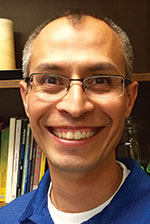Worship and Evangelization Outreach / Oscar Castellanos
Entering sacred ground through the art of listening and accompaniment
(En Espanol)
 What do the following stories have in common?
What do the following stories have in common?
Marcus is a 26-year-old man who just finished college, and he is still not sure what he wants to do next. After four years, he comes back home and begins to wrestle with the thought of entering seminary and offer up his life as a priest. By contemplating such a possibility, he asks God and himself what are the signs he should follow.
In another example, we have Martha, a mother of four children who are still in elementary school. She has been frustrated and upset during the past few weeks, since she has been at home helping them with their school work through technology, which she does not handle very well.
Martha, who has actively participated in her parish community in different groups and ministries, now concentrates entirely on helping from home. Martha’s faith has waned with these challenges. Her faith has not been nurtured by the sacraments and ministries in which she usually participates. As she contemplates her reality, she asks herself and God what are the signs she must follow.
We also have Daniel, an immigrant, who at the age of 50 has lost his job. Now unable to provide for his family, he questions God. Although he does not consider himself a person of deep faith, he has never ceased to entrust his life to God, especially in times of need.
Daniel had no Plan B. He never imagined losing his job at this point in life, but he refuses to deny God. On the contrary, in a prayerful moment, he asks God: what are the signs I must follow?
All these stories, although different, share the same experience of being confused, hopeless and eager to ask questions.
It is a feeling of loneliness—not necessarily abandonment from God—but rather a solitude that invites them to go deeper in their relationship with God.
They inadvertently experience a need to be accompanied by someone. The question is by whom, and what type of accompaniment is appropriate.
Would it be enough to call a best friend and express their thoughts, or simply kneel and vent before God, who listens to everything? In our Christian tradition, we would say that spiritual direction is a very viable option for the type of accompaniment they each seek.
Until a few decades ago, spiritual direction was primarily for priests, religious, or men in the seminary in formation for the priesthood, and not so much for the laity. Even more interesting, spiritual direction was not offered to lay men, much less by women.
I still remember with sadness the time a woman directee called me and said: “We have to cancel our sessions because my husband is convinced that this is not from God, since spiritual direction can only be given by priests.”
This experience taught me that there are still certain cultures where clericalism predominates, and it also confirmed that we still need to educate our communities about this ministry.
Spiritual direction should not be confused with psychological help, or with counseling, nor should it be equated to some type of coaching.
Spiritual direction focuses on a relationship with God, a person’s present and eventually the discernment of his or her will. Therefore, therapy is not a part of spiritual direction, although sometimes the spiritual director might have knowledge in behavioral sciences.
No one should come to spiritual direction to solve problems or conflicts, although at times the director might recommend and suggest something concerning the issues that the directee expresses. The main difference is that the relationship with God always continues; that is why spiritual direction does not end when a problem has been solved.
Although it is an old practice in our Catholic tradition, we still know little about spiritual direction, especially in certain cultures and ethnic groups.
Spiritual direction is an authentic ministry within the pastoral care of the Church, where its primary focus is to help individuals find the will of God and carry it out in their daily lives.
The simplest way to view this ministry is that of a Christian (trained in certain areas) accompanying another in the art of listening, an experience similar to the encounter of Moses and the burning bush, where God asks him to remove his sandals because he was stepping on sacred ground.
Over the years as a director, I can say that while listening to the religious experience of others, I am on sacred ground.
This is how Marcus, Martha and Daniel could benefit from this ministry, a space designed for the encounter, with a brother and/or sister who walks side by side. It is an encounter with the sole and foremost spiritual director, whom is the Holy Spirit.
(Oscar Castellanos is director of the archdiocesan Office of Intercultural Ministry.) †
 What do the following stories have in common?
What do the following stories have in common?